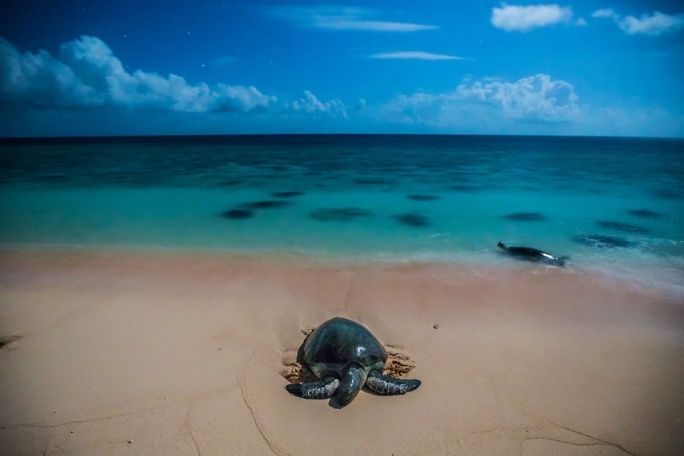Lesson summary
This lesson incorporates clips from Blue The Film as learning inspiration. Students explore marine turtles by firstly investigating the life cycle of marine turtles and then engaging in a guided discussion. They further their understanding of marine turtle life cycles and conservation by taking part in an interactive retell of the life of the turtle. Finally, students are asked to create a story, poem, drawing, painting, or perform a dance or play that describes their ideas about how we can all help marine turtles, both now and in the future.
Learning intentions:
Students can...
- engage in the theme of ocean conservation by investigating marine turtles.
Success criteria:
Students will...
- know what a marine turtle is and where it lives
- be able to retell what happens in the life of a marine turtle from the poem
- be able to share their thoughts with others
- be able to retell a story in a different format
- be able to suggest ways we can all help the marine turtle.
Lesson guides and printables
Lesson details
Curriculum mapping
Australian curriculum content descriptions:
Foundation English:
- Identify some features of texts including events and characters and retell events from a text (ACELT1578).
Year 1 English:
- Recreate texts imaginatively using drawing, writing, performance and digital forms of communication (ACELT1586).
Year 1 Science:
- Living things live in different places where their needs are met (ACSSU211).
Year 2 English:
- Create short imaginative, informative and persuasive texts using growing knowledge of text structures and language features for familiar and some less familiar audiences, selecting print and multimodal elements appropriate to the audience and purpose (ACELY1671).
Year 2 Science:
- Living things grow, change and have offspring similar to themselves (ACSSU030).
Syllabus outcomes: ENe-8B, EN1-10C, EN1-2A
General capabilities: Critical and Creative Thinking, Ethical Understanding
Cross-curriculum priority: Sustainability OI.1
Relevant parts of Foundation English achievement standards: Students recall one or two events from texts with familiar topics. They identify connections between texts and their personal experience.
Relevant parts of Year 1 English achievement standards: Students identify that texts serve different purposes and that this affects how they are organised. They describe characters, settings and events in different types of literature. They interact in pair, group and class discussions, taking turns when responding.
Relevant parts of Year 1 Science achievement standards: They describe changes in their local environment and how different places meet the needs of living things.
Relevant parts of Year 2 English achievement standards: Students understand how similar texts share characteristics by identifying text structures and language features used to describe characters and events, or to communicate factual information. Students create texts, drawing on their own experiences, their imagination and information they have learnt.
Relevant parts of Year 2 Science achievement standards: They identify that certain materials and resources have different uses and describe examples of where science is used in people’s daily lives.
Unit of work: Blue The Film: Inquiry – Foundation, Blue The Film: Inquiry – Years 1 & 2.
Time required: 60 min.
Level of teacher scaffolding: High – oversee activities, lead discussions and use of retell story pathway.
Resources required
- Device capable of presenting a website to the class
- A Turtles Life – Transcript (optional)
- Story Maps (or create your own on butcher’s paper) – one class copy and one for each group
Skills
This lesson is designed to build students’ competencies in the following skills:
- Communication
- Creativity
- Critical thinking
- Empathy
- Ethical understanding
- Global citizenship
Additional info
Blue is a feature documentary film charting the drastic decline in the health of our oceans. With more than half of all marine life lost and the expansion of the industrialization of the seas, the film sets out the challenges we are facing and the opportunities for positive change. Blue changes the way we think about our liquid world and inspires the audience to action. Find out how to screen or download the film here. Along with the film is an ambitious global campaign to create advocacy and behaviour change through the #oceanguardian movement. To become an ocean guardian, see the website.


Welcome back!
Don't have an account yet?
Log in with:
By signing up to Cool.org you consent and agree to Cool's privacy policy to
store, manage and process your personal information. To read more, please see
our privacy policy here(Opens in new tab).
Create your free Cool.org account.
Many of our resources are free, with an option to upgrade to Cool+ for premium content.
Already have an account?
Sign up with:
By signing up to Cool.org you consent and agree to Cool's privacy policy to
store, manage and process your personal information. To read more, please see
our privacy policy here(Opens in new tab).